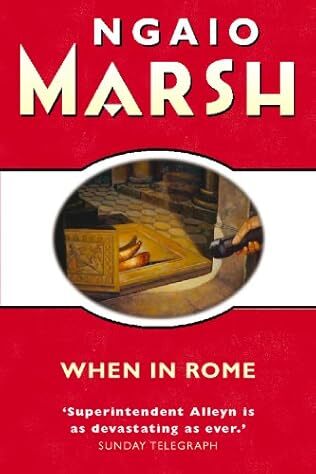When In Rome

A review of When in Rome by Ngaio Marsh – 250101
Perhaps it is about time as it is the twenty-sixth novel in Marsh’s Roderick Alleyn series, but When in Rome, originally published in 1968, shows some interesting changes from her usual approach to detective fiction writing. Alleyn takes a much less prominent role in the murder investigation, content to leave the most of the running to the local Italian police, his faithful assistant, Bre’er Fox, only makes a brief appearance providing background information on a couple of Brits, and there is even a touch of romance.
The biggest difference is that Alleyn’s secondary role allows him the freedom to play judge and jury and while he comes up with a radically different solution to what happened to Sebastian Mailer, he decides to let the murderer go free. Hitherto, Alleyn has been a stickler for allowing the law to take its course, once the truth has been unravelled, irrespective of personal feelings.
Alleyn is in Rome acting undercover, trying to obtain information about a gang of drug smugglers led by the criminal master mind, Ziegfeldt. His principal target is Sebastian Mailer who operates as a tour guide offering a tour of the recherche parts of Rome and a high old time. The addition of the successful novelist, Barnaby Grant, whose Simon in Latium has recently become a best seller, gives Mailer’s tour extra cachet, enabling him to attract a collection of wealthy and disparate clients, always useful when murder is afoot.
The party consists of a Dutch couple who are hopelessly devoted to each other and bear an uncanny similarity to one another – it’s the ears – as well as an Etruscan statue, a retired Major, Sweet, Sophie Jason, who works at Grant’s publishers, Sonia, Lady Braceley, and her son, Kenneth Dorne with Alleyn making up the numbers. Alleyn is surprised that Grant is involved with such a shady character as Mailer and, for once, the reader is one up on him because they have already read about the incident where Grant has his manuscript stolen and Mailer recovers it for him. The price is that Grant adds his glamour to what is really a sordid enterprise.
The action hots up when the party visit the Basilica di San Tommaso. A card seller verbally assaults Mailer and then is seen lurking in the shadows before disappearing, as does Mailer. The seller’s body is found dumped in a sarcophagus while, several days later, the body of Mailer is found down a well, Alleyn having to endure a dangerous descent to identify him. Later Sweet, whose cover Fox has helped to blow, is killed in a traffic accident as he tries to evade both arrest and a vindictive gang member.
The investigations reveal that Mailer has a hold on each of the male members of the party, adding blackmail to his litany of crimes and providing motives for his murder. Inevitably, the drug running and the murders dovetail but Alleyn is punctilious in ensuring that he only engages himself in the task that he was sent to Rome to carry out, to get the inside gen on the drug cartel.
Nevertheless, the Italian police’s rather simplistic reconstruction of the events that led to the murders does not gel with the facts as Alleyn sees them. Shoe polish, a revealing photograph and a spoilt film lead him to a different conclusion, one that given his empathy for the culprit he does not pursue with his usual vigour. However, he does disclose his theory in a letter to his wife, Agatha Troy.
I found this one of Marsh’s more enjoyable novels, perhaps because she tried something different and it seemed to work.



